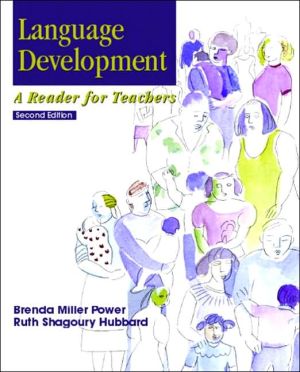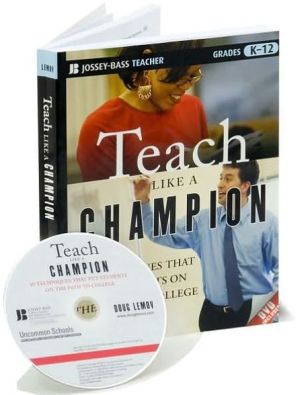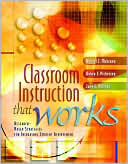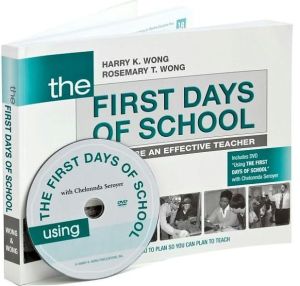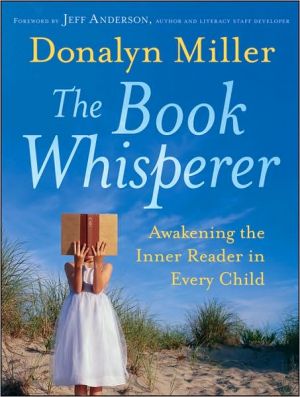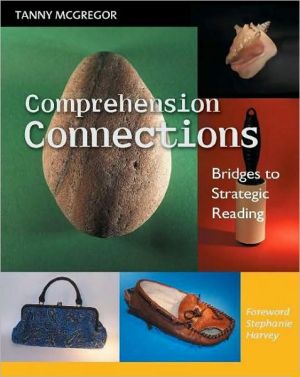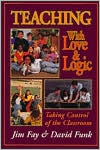Language Development: A Reader for Teachers
This classic book combines landmark studies from key theorists with practical classroom examples in language development. Current and future teachers are given step-by-step guidance regarding the theories behind language development and inquiry techniques for understanding and investigating links between language and literacy in the classroom. Upon completing the book, readers will have the ability to test theories by observing and documenting language in their classrooms. Learning How to...
Search in google:
Written for elementary school teachers, this textbook anthology offers guidance in understanding language development and collecting and analyzing data in the classroom. It provides historical perspectives exemplified by landmark studies, discuses verbal communication in schools, and details socio-cultural and personal perspectives. The contributors include linguists, psychologists, and educators like Rice, Piaget, Chomsky, Halliday, Newkirk, Schardt, Christensen, Ostrow, and Berube. Annotation c. Book News, Inc., Portland, OR (booknews.com)
There is something fascinating, almost magical, about the ability to speak. Though it is a common miracle played out each day, we are a long way from understanding the mysteries of language. Linguists have spent decades trying to unlock the codes of communication and have determined that human speech has very special properties that allow us to communicate at a rate 3 to 10 times faster than we could otherwise.\ There is more to language than speech, however, and anthropologists have spent as much time considering the links between culture and perception. Teachers must have the skills to both understand and build on the language of their students. Through understanding students' language, teachers hold the key to understanding their learning. TEXT FOCUS\ This reader is designed to take teachers into the domains of linguists and anthropologists. We believe it is important to read the studies of researchers who have shaped our understanding of how we develop language and use it to communicate meaning. But it is equally important to take that knowledge into the classroom, exploring how language can be used for genuine learning, for sharing understanding with others, and for delighting in the magic of language. We have included many studies of language from classrooms, written by teachers. These stories help us all understand how language develops and changes over time—and how this knowledge can help us change classroom practice for the better.\ To take the dialogue further, we invited three language researchers to tell us more about the process of their work—and, beyond their published research, what they are working on now, what motivates their research, andhow they link it to their teaching lives. Our interviews with Shirley Brice Heath, Deborah Tannen, and Karen Gallas challenge us to engage in a "passion for the ordinary," exploring closely what is occurring all around us.\ In A Map of the World, (1994; New York: Doubleday) Jane Hamilton writes about a two-year-old child, Lizzie, who is just learning to speak:\ She was just beginning to speak in short sentences. She was at the juncture in her baby-\ hood when it was possible she knew everything worth knowing. She understood the\ texture of her family; she understood the territory and rage and love, although she\ couldn't say much more than ball and moo, I want, pretty girl, and bad dog. As her\ language shaped her experience and limited her ideas, she would probably lose most\ of her wisdom for a time. . . Lizzie, at two, was on the brink, between stations. It was\ tempting to think that if only they could speak, infants could take us back to their\ beginning, to the forces of their becoming; they could tell us about patience, about\ waiting and waiting in the dark. (p. 27)\ \ The pieces in this reader can help give us a language to speak about language. We can understand that feeling a toddler has of losing knowledge for a time. Some of these readings will challenge you—as they have challenged us—to rethink some of your most cherished beliefs about language, learning, and culture. Learning about language has taught us much about patience, about waiting and listening closely to students so we can grasp multiple meanings beneath the words they use. TEXT ORGANIZATION\ Throughout this book we invite you to become a researcher of language in classrooms. We give guidance and many examples of teachers researching the language of their students. We've peppered the text with examples from novice teacher researchers who, like you, are just learning to analyze language—everything from purchasing tape recorders to coding tape transcripts to noting the way a head is held when someone laughs. We believe passionately that teachers can understand most deeply the lives and learning of their students if they are researchers within their own classrooms.\ After the introduction, the book is divided into three parts. These sections represent different "stations" of knowledge classroom teachers need to move through as they work with their students. Part I, Historical Perspectives and Landmark Studies, highlights major theorists who have shaped our understanding of how language is acquired. Teachers need to know the wide range of language development that is normal. Too often, differences within this wide range are equated in schools with deficiencies.\ Part II, Talk in Schools, is filled with examples of how teachers can change curriculum to support oral language development, as well as link oral language development to written language. In this section, teachers will see ways to listen carefully in the classroom, delight in the language communities they are a part of, and also learn to assess talk in the classroom in careful, systematic ways.\ Part III, Sociocultural and Personal Perspectives, tackles some of the complex issues of language and culture. Language is indeed a social construction, and does not exist in a vacuum. As our society becomes more diverse, it is even more important for teachers to understand how that diversity will be expressed in students' language.\ Sprinkled throughout the text are "Teacher Research Extensions"—examples of teachers applying the theories of language in the book to their own classrooms as they complete research studies.\ We hope you learn important concepts and theories about language within these pages; however, we know the best learning, about your students' "territories and rages and loves," can come only as you learn to listen to them closely and patiently. We hope you enjoy this reader as much as we enjoyed putting it together. Our aim is to bring us all to a new place in understanding, awareness, and celebration of the language our students use. ACKNOWLEDGMENTS\ We are indebted to the many teachers in our language development classes over the past decade, who bring such passion, humor, and integrity to their work every day in classrooms throughout the country. Their research and insights are infused throughout this book. Special thanks to Andie Cunningham, Joan Ellis, and Leeanne Larsen, who work alongside us teaching university language courses, and contributed useful ideas about language and teaching for this edition. James Whitney provided continuous friendly technical advice about tape recording and transcribing. Linda Montgomery is a smart, patient, and kind editor who measured her own words carefully in helping us improve the book.\ The reviewers for this second edition did an amazing job—they gave the best feedback we've ever received in terms of specific, concrete advice for making the book better. Many, many thanks to Carol Gilles, University of Missouri; Lola J. Ferguson, University of Wisconsin-Madison; Beth Berghoff, Indiana University-Indianapolis; Heidi Mills, University of South Carolina; and Betsy Rymes, University of Georgia. We value you all.\ B. Power\ R. Hubbard
Learning How to Research Language in Your Classroom1Pt. IHistorical Perspectives and Landmark Studies17Children's Language Acquisition19On Inner Speech28The Language and Thought of the Child33Language and the Mind36Encounter at Royaumont: The Debate Between Jean Piaget and Noam Chomsky43Relevant Models of Language49Ian Caught in Infancy54Myths About Acquiring a Second Language62What's Going On?69A Lot of Talk About Nothing74Crawling on the Bones of What We Know: An Interview with Shirley Brice Heath81Pt. IITalk in Schools89Do Teachers Communicate with Their Students As If They Were Dogs?91Teacher Research Extension: "You Talk Too Much"95Telling Stories97A Love of Words104Ways to Look at the Functions of Children's Language110Teacher Research Extension: An Unexpected Lesson in Language119What Should Teachers Do?: Ebonics and Culurally Responsive Instruction124Talking the Talk and Walking the Walk: Researching Oral Language in the Classroom129The Research Mind Is Really the Teaching Mind at Its Best: An Interview with Karen Gallas139Teacher Research Extension: Focusing on Student Talk153Examining Teacher Talk: Revealing Hidden Boundaries for Curricular Change156Inquiry Purpose in the Classroom161Pt. IIISociocultural and Personal Perspectives171Whose Standard? Teaching Standard English173American Sign Language: "It's Not Mouth Stuff, It's Brain Stuff"178An Interview with Hang Nguyen185Narrative, Literacy, and Face in Interethnic Communication189English Con Salsa193Silencing in Public Schools195It Begins at the Beginning206A Love of Language, A Love of Research, and a Love of Teaching: A Conversation with Deborah Tannen209Teacher Research Extension: "I'm Not Sittin' by No Girl!"215Yada-Yada-Yada: The Babbling Period Between Four and Eight Months of Age220Everyone Has an Accent225A Linguistic Big Bang231Life as We Know It237Name Index245Subject Index249
